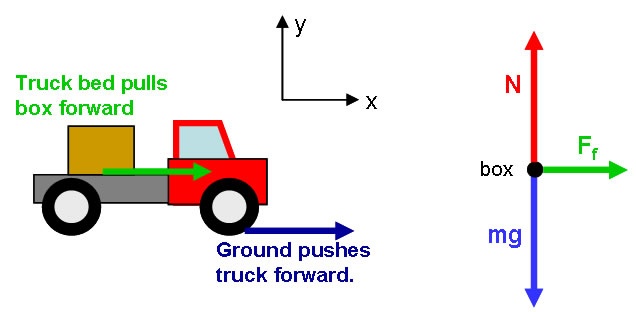Part A
A 15 kg box is sitting in the bed of a pickup truck. The truck begins to accelerate at a constant rate of 3.5 m/s2. Given that the friction between the box and the truck bed is characterized by a coefficient of kinetic friction of 0.25 and a coefficient of static friction equal to 0.40, what is the magnitude of the friction force acting on the box once the truck begins its acceleration?
Solution
System:
We will treat the box as a point particle.
Interactions:
External influence from the earth (gravity) and the truck bed (normal force and friction force).
Model:
Point Particle Dynamics.
Approach:
Diagrammatic Representation
We begin with a sketch that represents the situation, and then create the appropriate free body diagram.

Mathematical Representation
Using the free-body diagram, we construct the equations of Newton's Second Law applied to the box:

Since the truck is moving only in the x-direction, we expect ay = 0. Thus, we know that the normal force acting on the box will equal its weight. If friction is adequate, we expect that the box will accelerate in the x-direction at the same rate as the truck does. In that case, we expect:

It is important now to check that this result does not conflict with the requirement that

Since we have already used the y-direction equation of Newton's Second Law to conclude that the normal force on the box is equal to mg, we find:

We therefore conclude that our answer, Ff = 53 N, is compatible with the static friction limit.
Part B
Consider the same basic situation as above, but now suppose that the truck accelerates at a rate of 4.0 m/s2 rather than 3.5 m/s2. If the center of mass of the box is located 2.0 m horizontally from the edge of the truck bed, how much time will elapse from the instant the truck begins to accelerate until the instant the box falls off the truck bed?
Solution
System and Interactions:
As defined in Part A. We will also have to model the truck as a separate point particle in order to determine the time for the box to fall off.
Models:
Point Particle Dynamics and One-Dimensional Motion with Constant Acceleration.
Approach:
We begin with the same analysis as in Part A. Once again, friction is trying to keep the box moving at the same rate as the truck bed. This time, however, in order to accelerate the box at 4.0 m/s 2, the friction force would have to be 60 N
Unknown macro: {latex}
\begin
Unknown macro: {large}
[ F_
Unknown macro: {f}
= (15\:
Unknown macro: {rm kg}
)(4.0\:
Unknown macro: {rm m/sec}
^
Unknown macro: {2}
) = 60\:
Unknown macro: {rm N}
]\end
We found in Part A that the maximum possible static friction force on the box is 59 N. Thus, the box cannot accelerate at the same rate as the truck and will begin to slide.
Once we have determined the box will begin to slide along the truck bed, we must recognize we are in the kinetic friction regime. The box's acceleration, then, will be:
Unknown macro: {latex}
\begin
Unknown macro: {large}
[ a_
Unknown macro: {x}
= \frac{F_{f}}
Unknown macro: {m}
= \frac{\mu_
Unknown macro: {k}
N}
= \mu_
Unknown macro: {k}
g = 2.45\:
Unknown macro: {rm m/s}
^
Unknown macro: {2}
]\end
This acceleration is less than the truck's, and so the box will fall behind. To determine when the box falls off the truck, we must now use the equations of one-dimensional kinematics. Both the truck and the box have their own set of state variables and their own Law of Change. Since we are interested in time, we use:
Unknown macro: {latex}
\begin
Unknown macro: {large}
[x_
Unknown macro: {rm truck}
= x_
Unknown macro: {rm truck,i}
+ v_
t + \frac
Unknown macro: {1}
Unknown macro: {2}
a_
Unknown macro: {rm truck}
t^
]
[x_
Unknown macro: {rm box}
= x_
Unknown macro: {rm box,i}
+ v_
t + \frac
Unknown macro: {2}
a_
Unknown macro: {rm box}
t^
]\end
We can make these equations simplest by choosing the initial positions to be zero, and we also know that both the box and the truck began at rest. Thus, the equations become:
Unknown macro: {latex}
\begin
Unknown macro: {large}
[x_
Unknown macro: {rm truck}
= \frac
Unknown macro: {1}
Unknown macro: {2}
a_
t^
Unknown macro: {2}
]
[x_
Unknown macro: {rm box}
= \frac
Unknown macro: {1}
a_
Unknown macro: {rm box}
t^
Unknown macro: {2}
]\end
We now implement the information given in the problem statement by assuming that the box will fall off the truck when the truck gets dfall=2.0 m ahead. At this point, the center of mass of the box will be hanging off the back and the box will lose its support. We can write this condition as an equation:
Unknown macro: {latex}
\begin
Unknown macro: {large}
[x_
Unknown macro: {rm truck}
- x_
Unknown macro: {rm box}
= d_
Unknown macro: {rm fall}
= \frac
Unknown macro: {1}
Unknown macro: {2}
(a_
-a_
Unknown macro: {rm box}
)t_
Unknown macro: {rm fall}
^
Unknown macro: {2}
]\end
Solving for tfall, we obtain:
Unknown macro: {latex}
\begin
Unknown macro: {large}
[ t_
Unknown macro: {rm fall}
= \sqrt{\frac{2d_{\rm fall}}{a_
Unknown macro: {rm truck}
-a_
Unknown macro: {rm box}
}} = 1.6\:
Unknown macro: {rm s}
] \end




